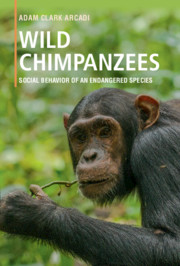Book contents
- Wild Chimpanzees
- Wild Chimpanzees
- Copyright page
- Dedication
- Contents
- Preface
- 1 Primates, Apes, and the Study of Chimpanzee Social Behavior
- 2 Seven Long-Term Field Studies
- 3 Chimpanzee Fission–Fusion Social Organization and Its Conservation Implications
- 4 Sex Differences in Ranging and Association Patterns
- 5 Female Social Relationships
- 6 Male Social Relationships
- 7 Sexual Behavior: Conflicting Strategies of Males and Females
- 8 Coalitionary Lethal Aggression between and within Communities
- 9 Hunting, Eating, and Sharing Meat
- 10 Communication: The Form and Content of Signals
- 11 Community Differences in Grooming Postures and Tool Use: Innovation, Social Learning, and the Question of “Culture”
- Epilogue
- Appendix: Field Methods for Studying Wild Chimpanzees
- End Notes
- References
- Index
- Plate Section (PDF Only)
9 - Hunting, Eating, and Sharing Meat
Published online by Cambridge University Press: 01 June 2018
- Wild Chimpanzees
- Wild Chimpanzees
- Copyright page
- Dedication
- Contents
- Preface
- 1 Primates, Apes, and the Study of Chimpanzee Social Behavior
- 2 Seven Long-Term Field Studies
- 3 Chimpanzee Fission–Fusion Social Organization and Its Conservation Implications
- 4 Sex Differences in Ranging and Association Patterns
- 5 Female Social Relationships
- 6 Male Social Relationships
- 7 Sexual Behavior: Conflicting Strategies of Males and Females
- 8 Coalitionary Lethal Aggression between and within Communities
- 9 Hunting, Eating, and Sharing Meat
- 10 Communication: The Form and Content of Signals
- 11 Community Differences in Grooming Postures and Tool Use: Innovation, Social Learning, and the Question of “Culture”
- Epilogue
- Appendix: Field Methods for Studying Wild Chimpanzees
- End Notes
- References
- Index
- Plate Section (PDF Only)
Summary
OVERVIEW
Wild chimpanzees hunt and consume a wide variety of small and medium-sized mammals as well as the occasional bird, small fish, and even snake (Table 9.1). Hunting is observed regularly at five of the seven long-term field sites, has been documented in many other populations, and probably occurs wherever prey species are available. Average frequencies at sites where it is common range between four and ten hunts per month, with considerable monthly and annual variation within and between communities. Both male and female chimpanzees hunt, but males hunt much more often and are responsible for the majority of kills everywhere. Primates are their most frequent prey, including individuals from at least sixteen monkey and five prosimian species (not including regional forms of red colobus and black and white colobus monkeys) as well as infant chimpanzees and, rarely, infant humans (Chapter 8).
Although meat constitutes only a small fraction of the chimpanzee diet, accounting for less than 5 percent of their feeding time on average, it is highly prized, as judged by the social excitement that accompanies episodes of prey capture and consumption. Unlike ripe fruits, which are the mainstay of chimpanzee diets at all study sites (Chapter 1), most prey are difficult to capture and are therefore usually hunted by groups of animals. Once a prey individual is killed, however, its carcass can be monopolized, inviting often intense competition for access to meat, with hunters as well as non-hunters performing charging displays, harassing possessors, avoiding aggressors, and vocalizing. An individual who makes a kill may succeed in retaining possession of the quarry, may have some or all of it taken from him or her, or may share parts of it with others (Plate 9).
High levels of arousal and competition during and following hunts suggest that meat is nutritionally important, presumably because it is a concentrated and easily digested source of protein and fat and provides a valuable source of micronutrients. Nevertheless, the fundamentally social nature of predation by chimpanzees raises a range of questions related to cooperation, exchange, and predator–prey dynamics and has consequently stimulated intensive research at the five long-term sites where it is most frequently observed. Several important issues remain unresolved and are the focus of ongoing investigations. For example, what factors influence the “decision” to hunt?
- Type
- Chapter
- Information
- Wild ChimpanzeesSocial Behavior of an Endangered Species, pp. 80 - 100Publisher: Cambridge University PressPrint publication year: 2018



